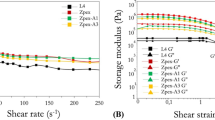Abstract
Commercial ceramics for dental computer aided design/computer aided manufacture (CAD/CAM) restorations suffer from surface chipping defects and microcracking. The influence of CAD/CAM machining of dental materials on the mechanical strength and extension of the damage zone was studied. Two different commercial dental ceramics, a feldspathic porcelain and a glass–ceramic, were CAD/CAM machined according to dental practice. The extension of the damage zone was analysed by a stepwise erosion of the surface, and the biaxial flexural strength was measured. To simulate the adhesive fixing of ceramic inlays, the specimens were sealed using a light-curing monomer. The different machining behaviour is dominated by the microstructure of the investigated materials. Owing to the high amount of glassy phase, the feldspathic porcelain shows extensive microcracking and chipping defects. The extent of the damage zone can be determined as 40–60 μm. Sealing of the surface did not affect the flexural strength of the machined samples. The dominating response to machining of the glass–ceramic is crushing and crumbling with a major contribution of plastic deformation on a microscopic scale. The extent of the damage zone is less than 20 μm. These cracks can be bridged by sealing of the surface, resulting in a substantial increase in strength. © 1998 Chapman & Hall
Similar content being viewed by others
References
J. W. McLean, Oper. Dent. 16(1991) 149.
K. A. Malament and D. G. Grossman,J. Prosth. Dent. 57(1987) 674.
J. Becker and D. Heidemann, Dtsch Zahnärztl Z. 48(1993) 611.
K.-H. Kunzelmann, J. Sindel and R. Hickel, J. Dent. Res. 72(1993) 187.
J. R. Kelly, H. Luethy, A. Gougoulakis, R. L. Pober and W. H. Moermann, in “Proceedings of the International Symposium on Computer Restorations”, edited by W. H. Moermann (Quintessence, Berlin, 1992) p. 253.
A. C. Shearer, H. O. Heymann and N. H. F. Wilson, J. Dent. 21(1993) 302.
ASTM Designation ANSI/F394-78, in “Annual Book of ASTM Standards”, Part 43, 1978(American Society for Testing and Materials, Philadelphia, PA, 1978).
S. Ban, J. Hasegawa and K. J. Anusavice, Dent.Mater. 8(1992) 100.
W. Moermann and O. Furrer, J. Dent. Res. 72(1991)516.
D. G. Grossmann, in “Proceedings of the International Symposium on Computer Restorations”, edited by W. H. Moermann (Quintessence, Berlin, 1992) p. 103.
G. Spur, “Keramikbearbeitung” (Carl Hanser, München,1989) p. 102.
W. Weibull, J. Appl. Mech. 18(1951) 293.
Author information
Authors and Affiliations
Rights and permissions
About this article
Cite this article
Sindel, J., Petschelt, A., Grellner, F. et al. Evaluation of subsurface damage in CAD/CAM machined dental ceramics. Journal of Materials Science: Materials in Medicine 9, 291–295 (1998). https://doi.org/10.1023/A:1008812929476
Issue Date:
DOI: https://doi.org/10.1023/A:1008812929476




